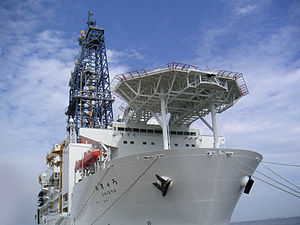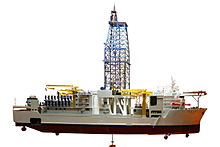Chikyū
 Chikyū
| |
| History | |
|---|---|
| Name | Chikyū (ちきゅう) |
| Namesake | Japanese word for "Earth" |
| Owner | CDEX |
| Operator | CDEX |
| Port of registry | |
| Builder | Mitsui Engineering & Shipbuilding and Mitsubishi Heavy Industries |
| Cost | 60 billion yen |
| Laid down | 25 April 2001 |
| Launched | 18 January 2002 |
| Acquired | 29 July 2005 |
| Homeport | Yokosuka, Kanagawa |
| Identification |
|
| General characteristics [1] | |
| Class and type | NK (Nippon Kaiji Kyokai) |
| Type | Ocean-going Drill ship |
| Displacement | 57,087 tonnes (62,928 tons) |
| Length | 210 m (690 ft) |
| Beam | 38 m (125 ft) |
| Height | 130 m (430 ft) |
| Draft | 9.2 m (30 ft) |
| Depth | 16.2 m (53 ft) |
| Propulsion |
|
| Speed | 12 knots (22 km/h; 14 mph) |
| Range | 14,800 nmi (27,400 km; 17,000 mi) |
| Complement | 200 |
| Crew | 100 |
Chikyū (ちきゅう) is a Japanese scientific drilling ship built for the Integrated Ocean Drilling Program (IODP). The vessel is designed to ultimately drill 7 km (4.3 miles) beneath the seabed,[needs update] where the Earth's crust is much thinner, and into the Earth's mantle, deeper than any other hole drilled in the ocean thus far.
While the planned depth of the hole is significantly less than the Russian Kola Superdeep Borehole (which reached 12 km or 7.5 miles depth on land), the scientific results are expected to be much more interesting since the regions targeted by Chikyū include some of the most seismically-active regions of the world. Other deep holes have been drilled by the drill ship JOIDES Resolution during the Deep Sea Drilling Project and the Ocean Drilling Program.
Operation[edit]
The Japanese part of the IODP program is called Chikyū Hakken (地球発見, Chikyū Hakken), Japanese for "Earth Discovery". Chikyū is operated by the Centre for Deep Earth Research (CDEX), a subdivision of the Japan Agency for Marine-Earth Science and Technology (JAMSTEC). JAMSTEC also operates the DSV Shinkai, Earth Simulator supercomputer and other marine scientific research projects. CDEX is responsible for the services to support activities including on-board staffing, data management for core samples and logging; implements engineering site surveys; and conducts engineering developments. CDEX contracts with the Mantle Quest Japan Company for the navigation of the ship.[citation needed]
The Chikyū Hakken program is part of an international scientific collaborative effort with scientists from the United States, ECORD, a consortium consisting of several European countries and Canada, China, South Korea, Australia and New Zealand (ANZIC), and India.[citation needed]
Design[edit]
D/V Chikyū was built by the Mitsui Engineering & Shipbuilding and launched on 18 January 2002 in Nagasaki, Nagasaki.[2] The ship was outfitted by the Mitsubishi Heavy Industries and delivered to JAMSTEC on 29 July 2005.[3]
The hull of the ship is 210 m (690 feet) long, 38 m (125 feet) in width, 16.2 m (53 feet) high, and has an approximate gross tonnage of about 57,000 tonnes (63,000 tons). The ship has a draft of 9.2 m (30 feet) and a maximum cruising speed of 12 knots (22 km/h; 14 mph). The amidships derrick is 121 m (397 feet) above sea level, and the top drive has a lifting capacity of 1,000 tonnes (1,100 tons). Its complement of 150 crew are divided between 100 operators and 50 science personnel, with at sea crew changes handled by helicopter transfer.[citation needed]
Key innovations include a GPS system and six adjustable computer controlled azimuth thrusters (3.8 m or 12 feet in diameter) that enable precise positioning to maintain a stable platform during deep water drilling. The maximum drilling water depth for riser drilling is 2,500 m (8,200 feet) and can support a drill string up to 10,000 m (33,000 feet) long.[citation needed]
The helipad can serve very large helicopters transporting as many as 30 persons per landing.[4]
History[edit]
The D/V Chikyū was built for deep-sea geological scientific research, which now includes not only research of earthquake-generating zones in the Earth's crust but also hydrothermal vents[5] and subsea methane hydrate research.[4]
On 16 November 2007 Chikyū began drilling the NanTroSEIZE transect as planned, reaching 1,400 m (4,600 feet) at the site of a future deep subsea floor observatory. The first stage of four NanTroSEIZE Stages was completed in February 2008. The whole project was envisioned to be completed by 2012.[6]
The ship was damaged by the 2011 Tōhoku earthquake and tsunami on 11 March 2011. The ship was moored 300 m (980 feet) off the coast of Hachinohe, Aomori, but was cut loose by the tsunami and collided with a pier of Hachinohe port. One of the six stabilizers was damaged and a 1.5-meter (4.9 ft) hole was made in the bottom. Local preliminary school children who were visiting the ship at the time of the earthquake spent one night on board and were rescued by Japan Self-Defense Forces helicopters next day. The ship was repaired at a dock in Shingū, Wakayama and returned to service in June 2011.[7]
World record[edit]
According to the IODP, on 27 April 2012, Chikyū drilled to a depth of 7,740 m (25,390 feet) below sea level, setting a new world record for deep-sea drilling. This record has since been surpassed by the ill-fated Deepwater Horizon mobile offshore drilling unit, operating on the Tiber prospect in the Mississippi Canyon Field, United States Gulf of Mexico, when it achieved a world record for total length for a vertical drilling string of 10,062 m (33,012 feet).[8] The previous record was held by the U.S. vessel Glomar Challenger, which in 1978 drilled to 7,049.5 m (23,128 feet) below sea level in the Mariana Trench.[9] On 6 September 2012 Scientific deep sea drilling vessel Chikyū set a new world record by drilling down and obtaining rock samples from deeper than 2,111 meters below the seafloor off the Shimokita Peninsula of Japan in the northwest Pacific Ocean. In addition, the 27 April 2012 drilling set a record for the depth of water for drilling of 6,960 m (22,830 feet). That record still stands.
In popular culture[edit]

The D/V Chikyū is featured and plays a pivotal role in the 2006 film Sinking of Japan.
See also[edit]
- Scientific drilling program
- Scientific drilling ships
- Mohorovičić discontinuity
- Earthscope
- USARRAY
References[edit]
- ^ CHIKYU HAKKEN|ちきゅうデータ Archived 24 November 2010 at the Wayback Machine, JAMSTEC (in Japanese).
- ^ 地球深部探査船「ちきゅう」に三井造船も貢献 Archived 13 May 2010 at the Wayback Machine, Mitsui Engineering & Shipbuilding (in Japanese).
- ^ Chikyū history page Archived 30 June 2007 at the Wayback Machine. Retrieved 27 August 2007.
- ^ a b
Mann, Charles C. (April 2013). "What If We Never Run Out of Oil?". The Atlantic Monthly. Retrieved 23 May 2013.
The Chikyū, which first set out in 2005, was initially intended to probe earthquake-generating zones in the planet's mantle, a subject of obvious interest to seismically unstable Japan. Its present undertaking was, if possible, of even greater importance: trying to develop an energy source that could free not just Japan but much of the world from the dependence on Middle Eastern oil.
- ^ The Deep Hot Biosphere Drilling. Archived 22 January 2013 at the Wayback Machine, Deep Hot Biosphere hydrothermal vents.
- ^ Chikyū's first mission complete Nature News, 19 November 2007.
- ^ 地球深部探査船:「ちきゅう」修理完了…津波で損傷 Archived 18 June 2011 at the Wayback Machine (in Japanese).
- ^ "- - Explore Records - Guinness World Records". Archived from the original on 17 October 2011.
- ^ "Japan deep-sea drilling probe sets world record". The Kansas City Star. Associated Press. 28 April 2012. Archived from the original on 28 April 2012. Retrieved 28 April 2012.
External links[edit]
- The Biggest Dig: Japan builds a ship to drill to the earth's mantle – Scientific American (September 2005)
- JAMSTEC's Chikyu Hakken Archived 2 May 2006 at the Wayback Machine
- Official Page for Integrated Ocean Drilling Program
- CDEX Homepage, JAMSTEC.
- NanTroSEIZE homepage at CDEX, JAMSTEC.
- MANTLE QUEST JAPAN COMPANY Archived 16 February 2020 at the Wayback Machine
- IODP Riser Vessel homepage
- T-Limit Expedition

